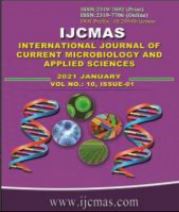


 National Academy of Agricultural Sciences (NAAS)
National Academy of Agricultural Sciences (NAAS)

|
PRINT ISSN : 2319-7692
Online ISSN : 2319-7706 Issues : 12 per year Publisher : Excellent Publishers Email : editorijcmas@gmail.com / submit@ijcmas.com Editor-in-chief: Dr.M.Prakash Index Copernicus ICV 2018: 95.39 NAAS RATING 2020: 5.38 |
Wheat (Triticum aestivum L.) is a one of the most important cereal crop after rice in the India which have suffers from a no. of devastating diseases caused by the many fungi, bacteria and viruses. Among the fungal diseases spot blotch (Bipolaris sorokiniana) is a most vital disease of wheat in Northern Eastern Plain Zone of India (NEPZ). The disease has causes considerable grain yield loss of the crop ranging from 18-22 percent. The field experiment was done with eleven different treatments including check with combinations of five different fungicides i.e. Propiconazole 25% EC, Folicure (Tebuconazole 25 % EC), Hexaconazole 5% EC, Nativo 75 WG (Tebuconazole 50 % + Trifloxystrobin 25 %) used as foliar spray. However, the fungicide Vitavax Power 75 WP and one bio-agent Pseudomonas fluorescence used as seed treatment for the management of the disease in the year 2017-18. The percent disease incidence (PDI) indicates that T7 (seed treatment with Vitavax Power 75WP @ 2.5g/kg seed with two foliar spray of Propiconazole 25% EC @ 0.1 % one at boot leaf stage and second after 20 days after first spray) reduced the disease incidence (32.96%). The 1000 grain weight, yield q/ha, avoidable yield loss and percent increase in yield were also highest in the aforesaid treatment (41.52g, 38.58q/ha, 19.31% and23.93%) respectively, as comparison to other treatment combinations.
 |
 |
 |
 |
 |